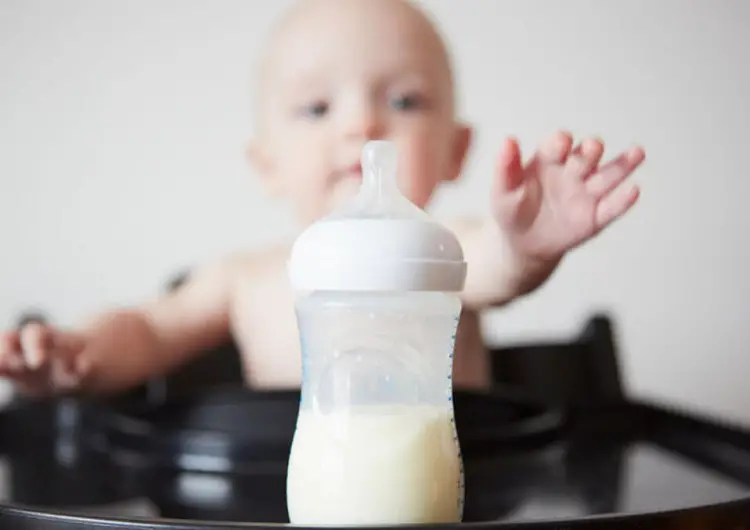Have you ever questioned the taste or the look of your breast milk? You find out your milk is not as smooth as when it was pumped, and you ask yourself, “Why your thawed breast milk looks grainy?” As you may know, many nursing moms go through this, don’t worry. You’re not alone.
Pumping breast milk for your baby can be a daunting task. During this period, almost everything your doing is put on hold for you to effectively and safely pump that milk.
Most times, as a mom, you may be unable to breastfeed your baby with freshly pumped breast milk for various reasons. Freezing the milk becomes the best option for you to consider for later use.
Imagine thawing your breast milk, only to find it with chunks and not as smooth as when you last pumped it.
This can be frustrating; you may wonder if all your hard work has gone to waste, especially if you’re a first-time mom.
In this article, we talk about why your thawed breast milk looks grainy, what you should do and how to know if thawed breast milk is bad.
Why Thawed Breast Milk Looks Grainy
Naturally, breast milk separates during storage because it’s not homogenized.
The foremilk and hindmilk are separated into a creamy layer (containing fats and proteins) and a watery layer. The fat rises to the top, and the water goes to the bottom during storage.
When breast milk is thawed, it may take on a chunky or grainy consistency. When this happens, don’t be in a rush to pour it down the drain because it’s completely normal for breast milk to change texture after freezing and thawing.
According to the NCBI (National Center for Biotechnology Information), U.S National Library of Science, freezing breast milk alters the physical appearance of its main components.
It breaks the fat globule membranes and alters the casein micelles. If the breast milk is stored correctly, following all the recommended guidelines, it should be okay.
However, as a concerned mom, you want to give your milk the smell test.
As you should know, breast milk gets spoiled and separates usually. If the milk has a distinct sour smell, it has gone bad and should be thrown away immediately to prevent feeding it to your baby. However, you’ll notice that the milk is fine in most cases.
Related Post: Why Does My Breast Milk Taste Salty
How Can I Tell If Thawed Breast Milk Is Bad
1. Foul Smell
Breast milk with a foul smell can indicate that your milk has gone bad. If this happens, it will smell similar to rotten cow’s milk. You won’t want to keep it anywhere close to your nose because this type of smell can make you want to gag.
However, breast milk smells “bad” but doesn’t always mean it’s spoiled. According to Georgakopoulos, “Breast milk can break down and release certain smell from enzymes,” “This smell can either be a metallic smell or a soapy smell, but doesn’t mean that the milk has gone bad.
Most times, this does not affect how a baby feeds, but the smell may trigger some.” When in doubt, though, you’re better off safe than sorry when your milk doesn’t pass the sniff test, says Georgakopoulos.
If the smell or taste of your milk is questionable, it is best advised to throw it out to prevent feeding it to your baby, she explains.
2. It’s Been In The Fridge For Longer Than 4 Days
Georgakopoulos says that fresh breast milk can be refrigerated up to 4 days, but if it has been drunk, it should be used within 24 hours,” Only pour in the right quantity of what you think will be used in a bottle just to be safe.
Any breast milk in your fridge for more than four days should not be reused. For maximum life span, store your milk in the “center” of your fridge and not in the door, where the temperature is not steady.
It’s necessary to label all of your pumped breast milk to help you keep track of time. According to Petersen, “Its best advised for nursing moms to label all their breast milk storage containers with the date at which the milk was pumped”. This will help you to set up a strategy to ensure the oldest milk is used first.
3. Milk Doesn’t Mix When Swirled
According to Georgakopoulos, “Naturally breast milk separates as it settles in the container, and this can sometimes be mistaken for going bad as the fat goes to the top of the container. This can be mistaken for curdling/souring.
While swirling it around should help re-constitute the milk, if your breast milk doesn’t mix when swirled, or if there are chunks in the milk that refuse to mix, it’s best to take a closer look to make sure that your milk has been stored properly and it’s not spoiled.
Petersen suggests, “Moms should not decide if their breast milk has gone bad by just looking at it, smelling it, or even tasting it”. Therefore it’s vital to adhere to the recommended storage guidelines as closely as possible to ensure your breast milk’s safety.
4. It Has A Sour Tastes
Generally, the easiest method to check if your breast milk is sour is to taste it yourself. Georgakopoulos says that a sour taste can be an indication that your milk has gone bad,”
Smelling is best advised, but safe handling and good inventory are usually the best way since breast milk keeps very well.
Additionally, your breast milk can still taste “off” to you due to the enzymatic reaction. But Georgakopoulos suggests, “if in doubt, throw it out, or use topically.
Related Post: 6 Useful Ideas For Expired Breast Milk
5. If It Wasn’t Stored Properly
Petersen suggests, “When storing breast milk in the fridge or freezer, use a container (like Lansinoh or Mommy’s Precious) specifically designed for breast milk storage”.
These breast milk containers are space-saving and convenient. They’re made with safe plastics and designed to stand up to storage conditions. You can get them cheaply on Amazon.
Remember to label your breast milk with the date and remember the guidelines mentioned above for how you’re storing it to help ensure that your breast milk stays fresh.
If you’re storing it in the freezer, put it in the freezer immediately after pumping, and store it in the main part of your freezer instead of the door.
For moms that may be pumping at their workplace or another place away from home, you should cool the milk in the fridge or a cooler bag immediately after pumping. Once you are home, transfer milk to the freezer, Petersen says.
The best way to thaw your frozen breast milk is to put it in the fridge overnight, says, Petersen. “If you need it urgently, storage bags can be run under warm tap water or sat in a bowl containing warm water for about 10 minutes for a fast thaw,” she says.
Related Post: Why Does Milk Turn Yellow When Frozen? Find Out
What You Should Do With Grainy-Looking Breast Milk

Now you know that not all grainy breast milk is bad, so what should you do about it? Not only do chunks in breast milk look displeasing for you to give your baby, but it also clogs the nipples of the feeding bottle making feeding difficult.
Here’s how you can boost the consistency of your breast milk and make the chunks almost disappear.
Warm and Swirl
If your breast milk is thawed overnight in the refrigerator, which is highly recommended, you may need to warm it.
To do this: Simply mixing it with a spoon may not do the job. Just warm the milk by putting the storage bottle in a bowl with warm water so the chunks can dissolve. After that, swirl the milk a bit to create a smooth consistency.
Shake the Bottle
Try shaking the bottle gently so the fat can mix with the rest of the milk. Don’t be discouraged by claims that shaking breast milk can make it lose its nutrients. There’s no scientific research on the ground to prove that.
However, avoid shaking it too hard though; the air may cause gas in your baby, so only shake it for a few seconds.
Use a Blender
This should be your fallback as your blender may be multipurpose, and you need to reduce the chances of bacterial contamination.
To do this: Simply put your milk in a clean container and use a sanitized immersion blender to give it a smooth consistency.
Related Post:
- How To Thicken Breast Milk With Oatmeal
- Why Your Breast Milk Smells Like Eggs
- Why Do My Breasts Leak When Baby Cries? Explained
Conclusion
I hope this article answers your question, “Why your thawed breast milk looks grainy?” As stated above, the best approach to thaw your frozen expressed breast milk is to place it in the refrigerator overnight.
The following day, warm the milk by holding the bottle in the kitchen sink under warm running water. Avoid refreezing your milk once it has been thawed, as this can encourage bacterial growth and cause further breakdown of nutrients.
Also, remember that sometimes your thawed breast milk will be smooth without chunks. There’s a higher chance of the breast milk going bad if you allow it to sit longer in the freezer.
All these storage guidelines must be put into consideration during the nursing period. Failure to do so can affect the taste of your breast milk, and if your baby tastes something he/she doesn’t like, she may find a reason to go on a nursing strike.
